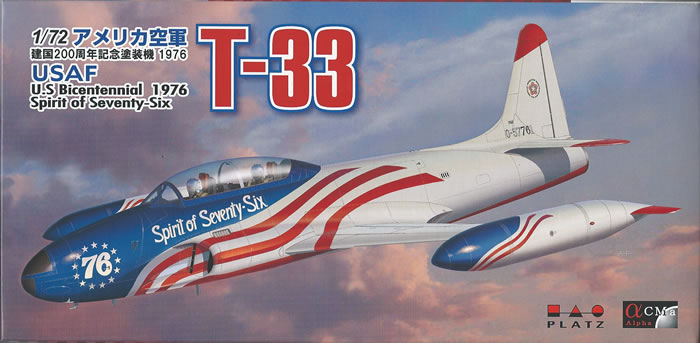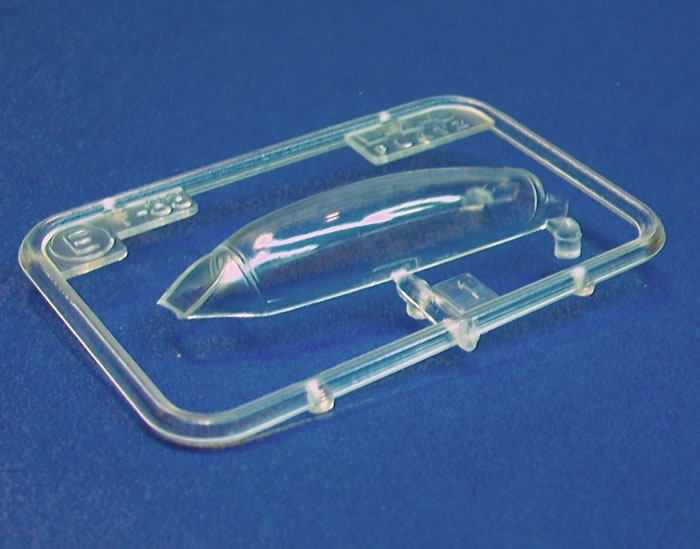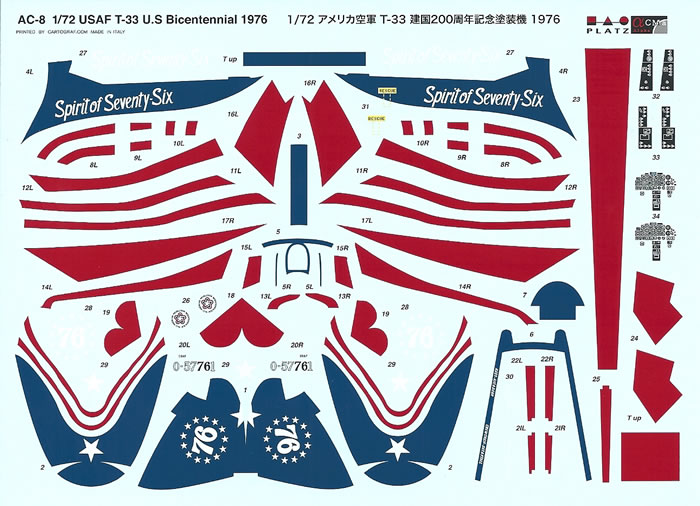Lockheed T-33
“US Bicentennnial 1976”

Platz, 1/72 scale
S u m m a r y : |
Catalogue Number: |
Platz Kit No. AC-8 - Lockheed T-33 US Bicentennnial 1976 |
Scale: |
1/72 |
Contents & Media |
One clear styrene and fifty-five grey styrene parts, with decals for one subject. |
Price: |
Available online from these stockists: |
Platz Models |
Hobby Link Japan |
Aviation Megastore |
¥2,310 |
¥1,760 |
€23.49 |
Review Type: |
First Look. |
Advantages: |
Accurate, good quality moulding, nice surface detail and excellently printed decals. The innovative intake engineering is a very good solution to avoiding complex seams, |
Disadvantages: |
Only one decal scheme offered. |
Conclusions: |
This is a nice kit with good surface detail and adequate interior detail for the scale. Platz’s after-market PE set is capable of improving detail levels, but raises the cost considerably.
It has more accurate tail surfaces and wing-root glove vanes than its closest competitor made by Sword, and should be a slightly easier build. However, aside from these points it falls short of the Czech kit in terms of interior detail and choice of decals.
Whilst this is good kit, and one that I really like, the Sword kit will be a better value proposition in the eyes of many. I recommend Platz's kit mainly to those who like nice straightforward builds in preference to limited-run kit alternatives, even when these have better interior detail. |
Reviewed by Mark Davies

HyperScale is proudly supported by Squadron.com
The first US jet aircraft was the Bell P-59, but the Lockheed P-80 that flew just a little later was an altogether better design. It was the product of a brilliant Lockheed “Skunk Works” design team led by “Kelly” Johnson. The first airframe was developed and delivered within a staggering 143 days, with prototype’s first flight occurring in January 1944. Just missing combat in WW2, the P-80, later to be redesignated F-80, was to see active service as a fighter, fighter-bomber and photoreconnaissance platform in the Korean War; although the F-86 Sabre soon superseded it in the fighter role.
Early on Lockheed had suggested the development of a two-seat P-80 to the USAF, but the air force brass did not appreciate the need for a jet trainer at the time. There was a change in official thinking by 1947 however, as difficulties in transitioning from piston-engined types to jets became more apparent.
Developed from the P-80C, the TF-80C (soon to be redesignated T-33) introduced tandem seating and a long canopy. Lockheed extended the fuselage by inserting a 26-inch plug in the cockpit area and another of 12-inches in the mid-fuselage. An armament reduction from six to two .50” M3 machineguns occurred (although many T-33’s had no guns fitted). It first flew in March 1948.
The T-33 was an outstanding success and widely exported to over 30 countries, as well as being licence-produced in Canada and Japan. Light attack and photoreconnaissance variants were also developed. The design was further developed and highly modified for US Navy use, and known as the T2V –1/T-1A Seastar. This had a raised cockpit line, leading-edge slats, tail hook for carrier landings, and was the first US aircraft to have boundary layer control using engine bleed-air. Lockheed also developed a radar-equipped after-burning all-weather interceptor derived from the T-33; called the F-94 Starfire.
T-33 production reached almost 6,600, and several are still flying in private hands as warbirds.
Previous 1/72 T-33 Shooting Stars
I am aware of three previous T-33 kits in 1/72 scale. Hasegawa’s was the first. It is an old kit with fine raised panel lines, rather basic detail levels, and has appeared in several different boxings over the years. Heller produced a very nice kit some time after Hasegawa. Also with raised panel lines, this offers superior levels of detail, and I have read that it is the more accurate of the two (except possibly for the horizontal stabiliser). Around about mid-2010 Sword released a modern limited-run multi-media kit that I reviewed here on HyperScale. This is a very good kit with high levels of detail and comes in at least two boxings with a range of decal options.
Prologue
This is the second boxing of the Platz T-33 kit I have reviewed. My first review looked at the Platz kit with Japanese markings and a separate PE detail set also by Platz intended to enhance their kit. I was critical of both the kit and combined package as being poor value propositions when weighed against the Sword kit. The lines and surface detail of both brands were similar, but the Sword kit provided far superior internal detail. The PE set helped the Platz kit in this regard (although it still lacked seat-belts), but pushed the combined price too high.
I have since learned from this feedback to my first review (by HyperScaler jbank) that the Platz kit’s tail surfaces are more accurate than Sword’s, and that it better portrays the wing-root glove vanes. Consequently, in this review I have tried to rebalance the scales of comparison to account for this point.
The Contents
The kit comes in a typical Japanese top-opening box made from good quality glossy card. Written instructions are predominantly in Japanese, although the aircraft’s history is in English. The instructions are easy enough to follow with simple but clear diagrammatic assembly stages. Colour call-outs are I suspect related to the Gunze Sangyo and Mr Color paint ranges, but most useful is their provision of FS-595 codes as well. The parts come enclosed in a plastic bag, with the clear parts and decals further protected in their own bags.
As with other Platz kits I have reviewed, I found crisply moulded parts with delicate engraved panel detail. However the undercarriage doors have sink marks present, but these should be easy to deal with. The colourful decals appear very well printed.
The Airframe
Cockpit detail is reasonable for the scale with crisp raised detail on the instrument panels and consoles, and there are decals for these parts as well. The seats are an acceptable facsimile of the real thing, although moulding the footrests with the floor does fails to capture their true appearance. The clear canopy is also well done, but is a single piece. This is something that those who choose to buy the extra PE detail set may regret, as they will have to cut the canopy to show off the interior to best advantage.

Parts breakdown is a little unconventional for this subject. Other T-33 and P-80 kits such as Sword’s split the air intakes from mouth to duct horizontally, incorporating the top part with the fuselage and the bottom with lower the wing halves. This in turn makes for some awkward joints and filling issues. Platz has a very simple and effective solution that avoids joins in the intake mouth area. They mould the mouth and first part of the intake duct as one piece that is deep enough to provide the internal ducting as well. The intakes attach to the fuselage and wings along simple straight join lines that I doubt will need any filling, but if they do will be easy to access.
The other unusual feature of the kit’s parts breakdown is the separation of the fuselage at the break-line for engine removal. There is some internal structure detailed inside the rear fuselage and a bulkhead with holes for intake ducting just behind the cockpit. This all suggests that an engine was to have been included, or will be in a future edition. The kit provides instead just a long exhaust duct and nozzle. I hope that the added complexity of the additional fuselage join will not present any problems.
In all other respects the parts breakdown and constructional sequence is conventional. There are separate air brakes and acceptably detailed undercarriage parts, but there is nothing out of the ordinary in terms of detail or finesse.
Colours and Markings
The kit offers only one set of markings, these being for a 1976 special US Bicentennial scheme “Spirit of Seventy-Six”. This is a striking enough scheme, but I doubt it will be everybody’s cup of tea. It will no doubt have most appeal within the US market, but given the kit’s asking price, I would like to have seen several markings options covering some export users as well.

The decals look excellent, with very good registration and suggest good opacity. The decals are multi-piece with cut out sections to aid in conforming to the compound curves that they must cover. I have no idea as to how the decals will perform, and this could be a make or break aspect for an out of the box build. However, some may choose to paint much of the blue areas to reduce dependency on perfect decal performance. The painting and markings guide is thorough.
A Quick Comparison to Sword’s T-33
Platz’s T-33 release is less than two years after Sword’s kit. It is tempting therefore to compare the two briefly, especially as they represent a contrast in approach to kit manufacture.
I will not address at length the accuracy of the two kits as I am no T-33 expert and it generally lies outside the first look format I follow. I did however overlay the parts and found that almost all aspects of the airframe, tip-tanks included, conform so closely to each other that their outlines are essentially identical, although the tail surfaces have some slight differences.
In my earlier review, I thought that Sword is slightly closer to the real thing, but as mentioned earlier, I have since learned that the Platz kit has the better shape fin and horizontal stabiliser, along with a good representation of the wing-root glove vanes. Other very small differences include the size of the grills above and below the intakes, and I think here Platz may have a slight edge. In fact, I tend to favour the surface detail subtleties of the Platz kit, but my preference is marginal.
The Sword kit is good but being limited-run technology the parts have some flash, are not always as crisp as Platz’s (mainly the wheels), and lack alignment pins. Thanks to its resin content the Sword kit does offer considerably higher levels of internal detail out of the box, although much of the resin is related to the wheel well and air-brake bays, and so frequently will not be seen much. It may not build as easily as the Platz kit, but this is not to say it will be very difficult either. Feedback to my first review from HyperScaler Paul1953 who built the Sword kit confirmed this. It offers decal options across at least two editions with a wider appeal than the US Bicentennial or JASDF options the two Platz boxings provide. Finally, Sword offers a two-part canopy for those who wish to have it raised.
Platz’s T-33 is a simple and honest kit with adequate detail levels. Moulded well, it should assemble easily, especially given its clever intake parts design. Although I hope the separate rear fuselage will not cause any assembly problems. It has adequate detail levels for the scale, but these represent no advance over what mainstream brands offered 20 years ago. Platz does offer a separate pre-coloured PE set at around 65% of the kit’s price. This adds to the detail levels with nice instrument panels, consoles and canopy details. Nevertheless, it is amazing that a PE detail set primarily dedicated to the T-33’s cockpit would leave out seat harnesses and the prominent ejector-seat footrests.
As things stand, Platz will be an easier build than Sword and has a more accurate tail (not that the difference is huge). However, if detail is your thing then Sword looks to be a better bet for the money. If detail is not your priority, and a trouble-free build and with the best accuracy is, and you like the Thunderbird or the other boxing’s JASDF markings, then just buy the Platz kit without the PE set. You will still pay around 10% over the Sword price, but you should be happy.
This is a nicely engineered kit produced to high standards. The design of the intakes is simple but clever, and superior in my view to the way previous kits have addressed this aspect of the T-33’s airframe. I now understand it to be more accurate than the Sword kit due to a superior shaped tailfin and horizontal stabiliser.
The single US Bicentennial scheme is eye catching and will probably appeal most to the US market. Even so, I would have thought it would still have a rather limited appeal. Platz could have included or chosen instead some other interesting and attractive schemes given the international possibilities the T-33 offers.
Detail levels are adequate but unimpressive. For those prepared spend extra money (64% of the kit’s cost) the PE set goes some way to dress up the cockpit, and to a lesser extent the wheel-wells. I think it is better to spend any extra funds on Pavla resin seats and some after-market decals, unless you like the Platz markings.
I would be lauding the Platz kit most highly if we had only Hasegawa’s and Heller’s kits to compare it to, but it struggles in terms of detail when compared to Sword’s T-33 kit. It will build more easily than Sword, but maybe not by that much. Its more accurate tail surfaces mean that I must concede it offers a bit more compared to Sword’s kit than I stated in my first review of the JASDF boxing. However, I think many will still opt for Sword’s detail and decal choices as a better value proposition.
I like this kit a lot despite some of the forgoing commentary. If it equalled say a Tamiya kit’s internal detail, it would easily justify its price against Sword’s, but unfortunately, it does not. I still cannot reconcile the cost of Platz’s PE detail set with what it offers. This kit has the potential to produce a very good model of the T-33, but you will need either some Pavla seats or suitable seatbelts to do your model full justice, and most will want some other decals too.
Those with a quest for the last word in accuracy and a dislike of limited-run kits and lots of resin detail will opt for Platz over Sword, as will those who like a simple straightforward builds out of the box. I recommend the Platz kit these modellers.
Thanks to Platz Hobby for the review sample.
Review Text Copyright © 2012 by Mark Davies
Page Created 25 June, 2012
Last updated
25 June, 2012
Back to HyperScale Main Page
Back to Reviews Page

|
Home
| What's New |
Features |
Gallery |
Reviews |
Reference |
Forum |
Search